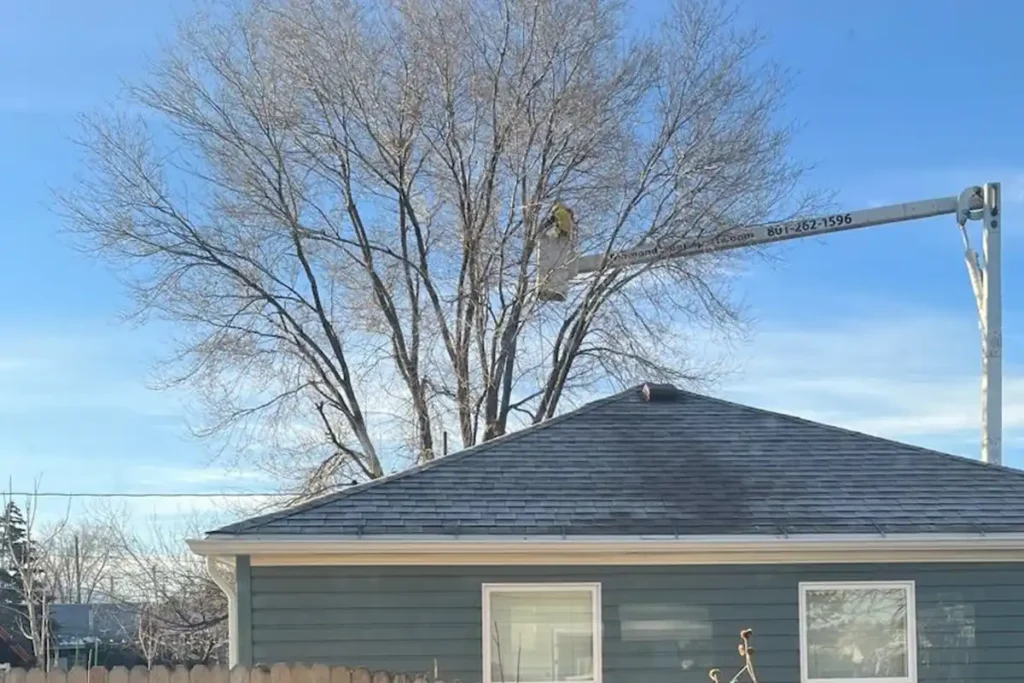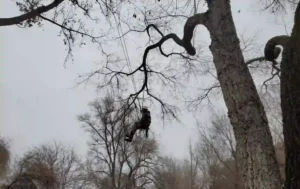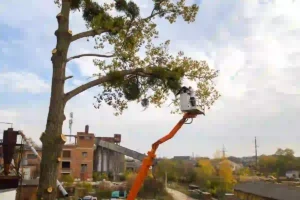The biggest mistakes people make when trimming trees? Three things. Hiring the wrong company, doing the work at the wrong time, and not understanding what they’re actually paying for. These errors cost anywhere from a few hundred dollars to several thousand. Sometimes they damage trees permanently. Or put property at risk.

How to Avoid Costly Mistakes When Trimming Trees
Hiring Someone Without Proper Insurance
This is probably the most expensive mistake possible.
If a tree trimmer falls from a 50-foot oak and breaks their back, and they don’t have workers’ compensation insurance, guess who’s liable. The property owner. That medical claim could hit hundreds of thousands of dollars.
Same thing happens if they drop a branch through a neighbor’s roof or damage power lines. No comprehensive liability insurance means the property owner pays for repairs. Always ask for proof of both liability insurance and workers’ compensation before anyone touches the trees. Not just a company name. Actual certificates with current dates. Call the insurance company to verify. Takes ten minutes. Could prevent financial disaster.
Real scenario that happens more than people think: contractor shows up, starts climbing, falls, has no workers’ comp. Homeowner ends up in court facing a lawsuit. Their homeowners insurance may not cover it because they hired an uninsured contractor. This has bankrupted people.
Skipping the Certified Arborist
Not everyone who owns a chainsaw knows how to trim trees correctly.
There’s a massive difference between someone who “does tree work” and an ISA certified arborist. Certified arborists understand tree biology. Disease management. Proper cutting techniques. How different species respond to pruning. All of it.
A bad cut leaves trees vulnerable to disease. Or causes them to grow back wrong. Oak trees need trimming during specific times of year to avoid oak wilt disease. In some regions, that means avoiding pruning from April through June when beetles that spread the disease are most active. Fruit trees require precision pruning if they’re going to produce fruit next season. The fruiting wood needs preservation while removing dead or crossing branches.
Pine trees and evergreens? Completely different approaches than deciduous trees. Never remove more than one-third of a pine’s foliage in a single year. It might not recover. Someone without training might top a tree (cutting the main leader). Sounds fine but actually causes long-term structural problems. Reduces the tree’s lifespan by decades. Looks terrible. Decreases property value by thousands.
Tree topping creates multiple weak leaders that compete for dominance. These branches have weak attachment points. They break during storms, creating hazards years after the bad pruning job.
Not Getting Multiple Written Estimates
Tree trimming costs vary wildly between companies.
A small tree under 25 feet might cost $150 from one company and $400 from another. Medium trees in the 25-50 foot range typically run $400-$800. But outliers exist everywhere. Large trees over 50 feet can range from $800 to $1,500. Extra large trees over 75 feet often hit $1,500 to $3,000 or more.
Get at least three written estimates. Not phone quotes. Written ones with details. Each estimate needs to specify exactly what work gets performed, what’s included in the price, what costs extra. Debris cleanup alone can add $100-$300 if it’s not included.
This is where something like treetrimmingcostcalculator.com helps. Get a baseline estimate before calling companies. Provides a reference point. Makes it obvious if someone’s trying to overcharge by 40%. The calculator factors in tree height, type, accessibility issues, local labor rates. Takes three minutes. Then actual quotes can be compared against that baseline.
One company quotes $600 for a job that should cost $400 based on local rates. Another quotes $250, which is suspiciously low and probably means they’re cutting corners somewhere dangerous.
Trimming at Peak Season Prices
Summer tree trimming costs significantly more than winter trimming. The difference can hit 20-30% or more.
Everyone wants their trees trimmed in June when weather’s nice and they’re having backyard parties. Peak demand season. Winter (December through February) is when tree service companies are slowest and most willing to negotiate. Trees are dormant. Actually an ideal time for trimming most species. Better availability. Better pricing. No competition with everyone else in the neighborhood for limited appointment slots.
Fall is second best. Early spring is moderate. But summer? Premium rates apply for the same work.
A medium tree that costs $500 in January might cost $650 in July. Multiply that across three or four trees and the difference becomes real money. Plus winter scheduling means crews can often come within a week or two. Summer might mean waiting six weeks for an opening.
Attempting DIY on Large or Complex Trees
Small ornamental trees under 10 feet? Fine. Basic trimming is manageable with proper tools and research.
But once height exceeds 25 feet. Or trees sit near power lines. Or dead limbs are involved. Or anything requires a ladder taller than comfort allows. Professionals are necessary.
People die doing tree work. Others end up in emergency rooms with chainsaw injuries. Lacerations. Amputations. Crush injuries from falling branches. Minor mistakes become serious when working 30 feet off the ground.
Even if injury doesn’t happen, trees can be damaged so badly they need complete removal. That turns a $300 trimming job into a $2,000+ removal and replacement project. Trees don’t forgive mistakes. Cut too much and they go into shock. Cut in the wrong place and decay sets in. Remove too many branches from one side and the tree becomes unbalanced and dangerous in wind.
Large trees over 50 feet require specialized equipment. Bucket trucks. Rigging systems. Professional-grade saws. This equipment costs tens of thousands of dollars. Requires training to operate safely. Bucket trucks need level ground and careful positioning. Rigging systems need calculation for weight and angles. None of this is intuitive or learned from YouTube videos.
Ignoring Accessibility Issues
If a tree sits in the backyard with no gate access. Or is surrounded by landscaping. Or sits next to a house within three feet. That affects price significantly.
Companies need to bring equipment in, position it safely, have space to work. Trees near power lines require special protocols. Sometimes coordination with utility companies. Some utilities won’t let private contractors work within ten feet of lines. They require their own crews to do it. They might take weeks to schedule.
Trees overhanging buildings need rigging to prevent property damage. A branch that weighs 500 pounds can’t just be cut and dropped when a roof is underneath.
These factors increase costs by 25-50% compared to an easily accessible tree in an open yard. A tree that would cost $400 with easy access might cost $600 when it requires hand-carrying equipment through a narrow side yard. Rigging every branch to avoid hitting the house.
Don’t hide these details when getting quotes. Companies will either refuse the job when they arrive. Or charge extra on the spot. Be upfront about obstacles. Overhead wires. Fence gates. Underground utilities. Proximity to structures. Honesty gets accurate quotes.
Not Considering Tree Type Requirements
Oak trees need different care than pine trees. Fruit trees need different care than palm trees.
This isn’t optional information. It’s the difference between a healthy tree and a dead one.
Oak wilt disease kills trees in as little as three months once infected. In affected regions, oaks should not be pruned during beetle season. Even painting cut surfaces with wound dressing doesn’t guarantee protection if timing is wrong. Fruit trees need pruning at specific times for optimal fruit production the following season. Prune too early and lose buds. Prune too late and stress the tree.
Palm trees require completely different techniques than traditional trees. The fronds need cutting at specific angles. Only dead or dying fronds should be removed. Remove too many green fronds and the palm weakens.
Evergreens shouldn’t be trimmed the same way as deciduous trees. Deciduous trees can handle aggressive pruning when dormant. Evergreens maintain foliage year-round. Can’t recover from heavy pruning.
If a tree service company doesn’t ask what type of tree they’re trimming. Or doesn’t adjust their approach based on species. That’s a red flag. Means they’re using a one-size-fits-all approach. Might work fine. Might cause serious problems three months later when disease sets in or the tree doesn’t leaf out in spring.
Falling for Abnormally Low Bids
If everyone’s quoting $600-$800 for a medium-sized tree and someone offers to do it for $250, there’s a reason.
Usually one of these: they’re not insured, they’re not licensed, they don’t know what they’re doing, or they plan to do a hack job and disappear.
Sometimes low-ball bids come from companies that start the work then discover “unexpected problems” that double the price. Or they do the bare minimum work and leave a mess to clean up. One crew might cut branches and haul everything away. Another cuts branches and leaves them in piles across the lawn.
Extremely low prices often mean cutting corners. Safety. Insurance. Equipment maintenance. Employee training. This increases the risk of property damage. Injuries. Poor quality work that harms trees.
A $250 job might save money upfront but cost $2,000 to fix later when the tree dies from improper cuts. Or when uninsured workers damage property.
Not Asking What’s Included
“Tree trimming” means different things to different companies.
Some include debris cleanup and hauling. Others cut and drop everything in the yard. Leave the property owner to deal with piles of branches. That cleanup might cost another $200-$400 if it has to be arranged separately.
Some quotes include stump grinding. Some don’t. Some include treating cut areas to prevent disease. Some don’t. Make absolutely sure the written estimate specifies what’s included before agreeing to anything.
Ask specific questions. Who hauls the debris? How large will the wood pieces be? Will branches be chipped or left whole? Will they rake up small debris? Will they avoid driving equipment across the lawn? These details matter. Create surprise charges if not discussed upfront.
Skipping Regular Maintenance
People often wait until trees are severely overgrown before calling a tree service. This turns routine maintenance into a major project.
A tree that needs heavy trimming because it hasn’t been touched in five years costs significantly more than one that gets light pruning every year or two.
Regular maintenance costs less per visit. Keeps trees healthier. Light annual trimming might cost $150-$300. Waiting until heavy corrective trimming is needed could cost $800-$1,200 for the same tree. The work takes longer. Requires more expertise. Generates more debris.
Trees that get regular maintenance also live longer. Look better. They develop strong structure without weak branches or crossing limbs. Less likely to drop branches during storms. Or develop disease entry points from old wounds that never closed properly.
Not Checking Reviews and References
Ten minutes on Google or the Better Business Bureau tells everything needed about a tree service company.
Look for patterns in reviews. One or two complaints? Fine. No company is perfect. Dozens of complaints about property damage, incomplete work, or billing disputes? Stay away.
Ask for references from jobs similar to the situation at hand. If there’s a 60-foot tree near power lines, references from customers with similar situations matter. Not someone whose tiny ornamental tree was trimmed in an open yard.
Call those references. Ask specific questions. Did they show up on time? Did they clean up completely? Were there any surprise charges? Would you hire them again? Did they damage anything? How did they handle problems if something went wrong?
Scheduling Last Minute
Emergency tree service costs more than scheduled maintenance.
If a storm damages a tree or a dead limb becomes dangerous, premium rates apply because companies know there’s no time to shop around. Or wait for better pricing.
Emergency rates can be 50-100% higher than regular rates. A job that would normally cost $600 might cost $900. Even $1,200 as emergency work.
Plan tree trimming during off-peak seasons. Book in advance. Better dates. Better prices. Better service quality because the crew isn’t rushing between five other emergency calls.
How to Actually Avoid These Mistakes
Use treetrimmingcostcalculator.com to understand baseline costs before talking to companies. This prevents getting surprised by quotes. Or accepting unreasonable prices because there’s no reference point.
Enter tree height. Type. Accessibility details. Zip code. The calculator gives realistic cost ranges based on the specific situation.
Then get three written estimates from licensed, insured companies with certified arborists. Verify their insurance. Check their reviews. Ask about what’s included. Schedule during off-peak seasons when possible.
Compare the quotes against the calculator estimate. If someone’s way below the range, be suspicious. If someone’s way above, ask why. Maybe the tree has complications that warrant higher pricing. But they should be able to explain it clearly.
Most important thing? Don’t make decisions based purely on price. The cheapest option often ends up being the most expensive when factoring in poor work quality. Property damage. Having to hire someone else to fix mistakes.
The goal is finding the best value. Qualified professionals. Fair pricing. Comprehensive service. Reliable results.
Tree trimming done correctly protects property. Maintains tree health. Can last several years before needing attention again. Done incorrectly, it creates expensive problems that take years to fix. Or require complete tree removal.
Taking time to avoid these common mistakes saves money and hassle in the long run.



